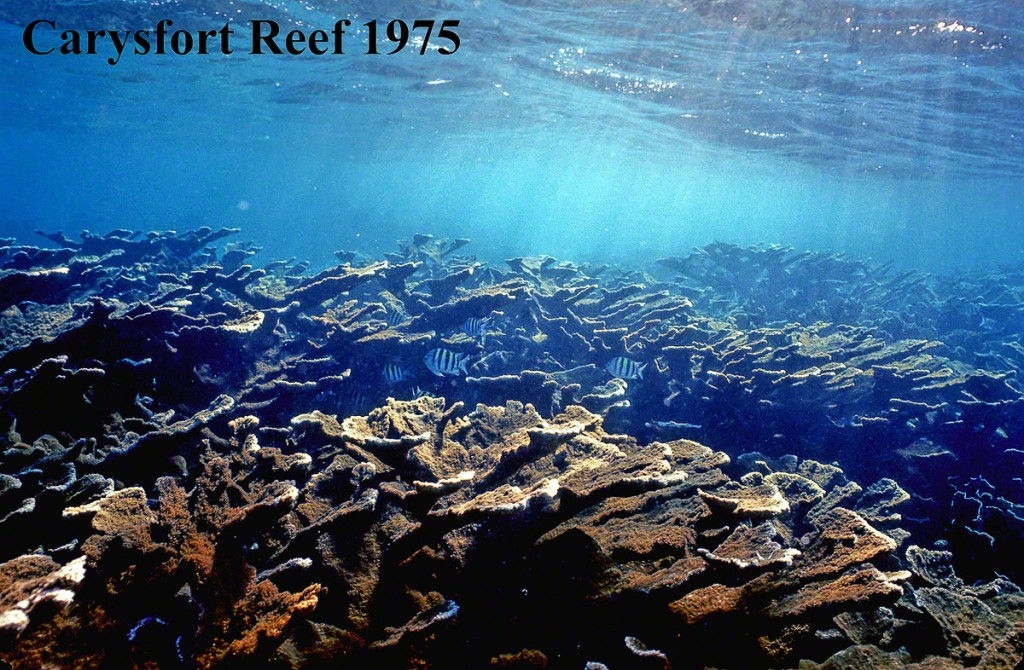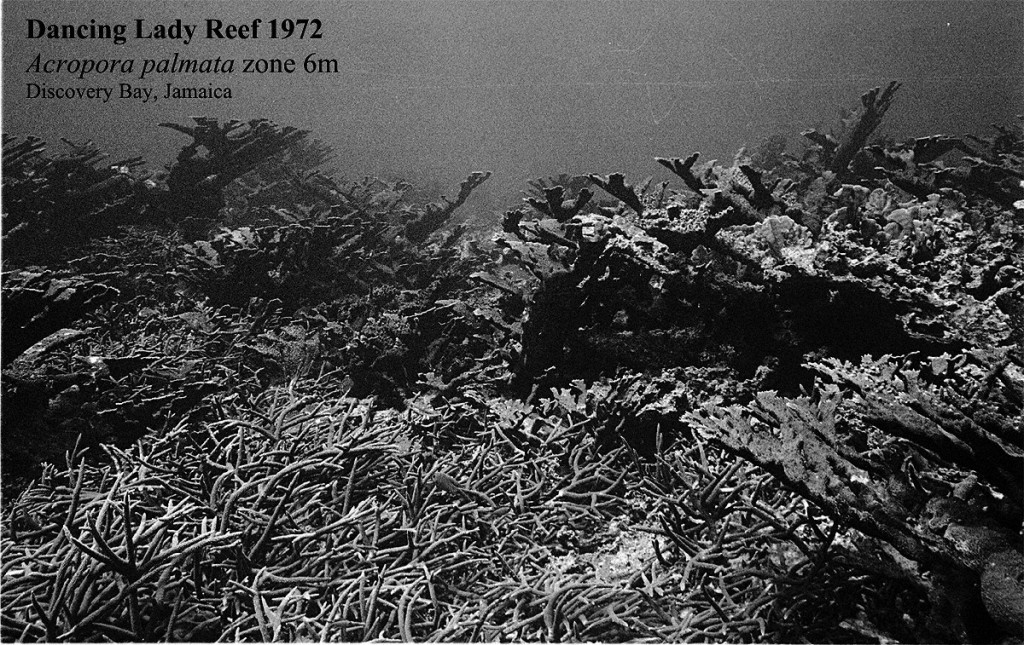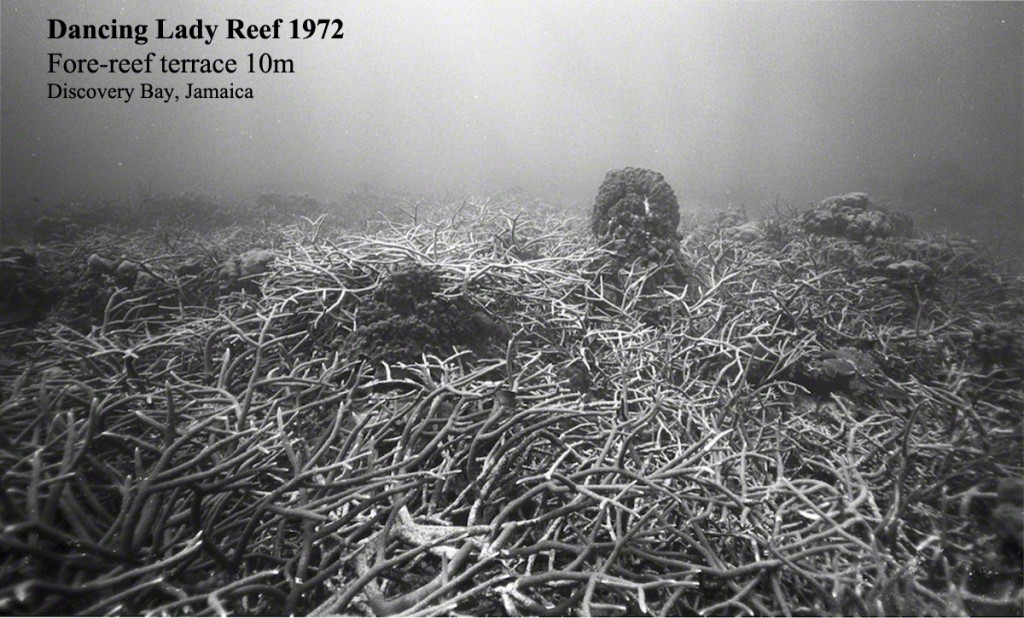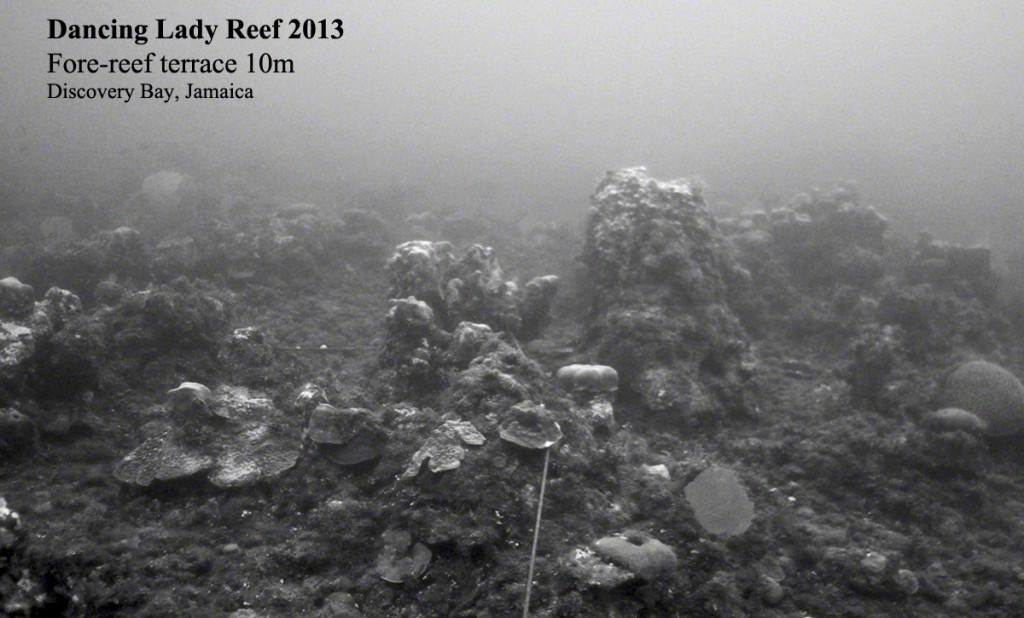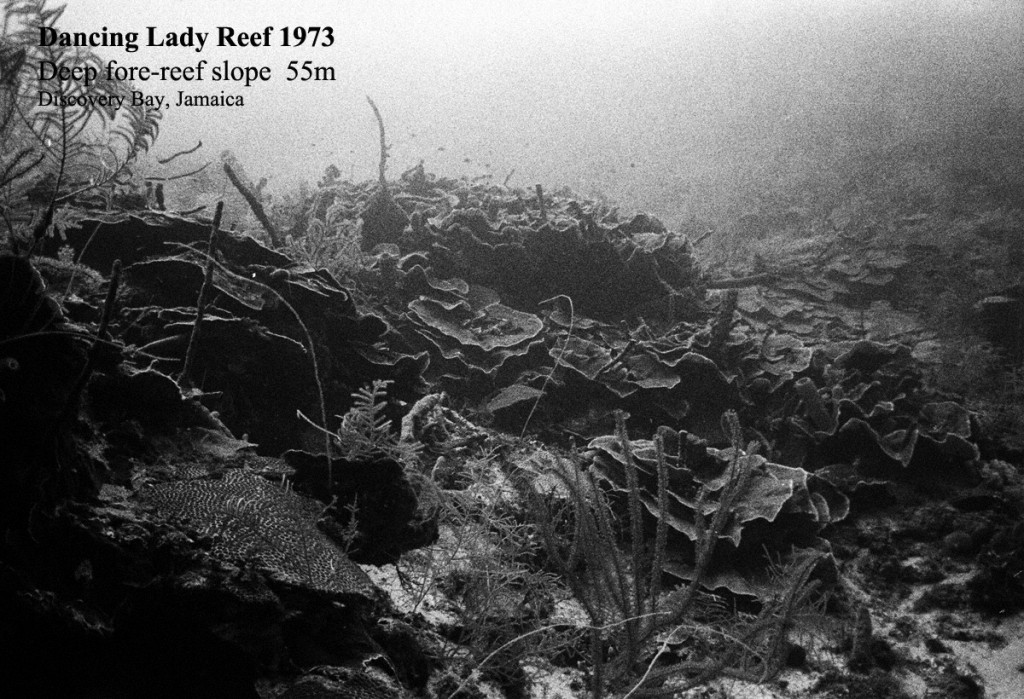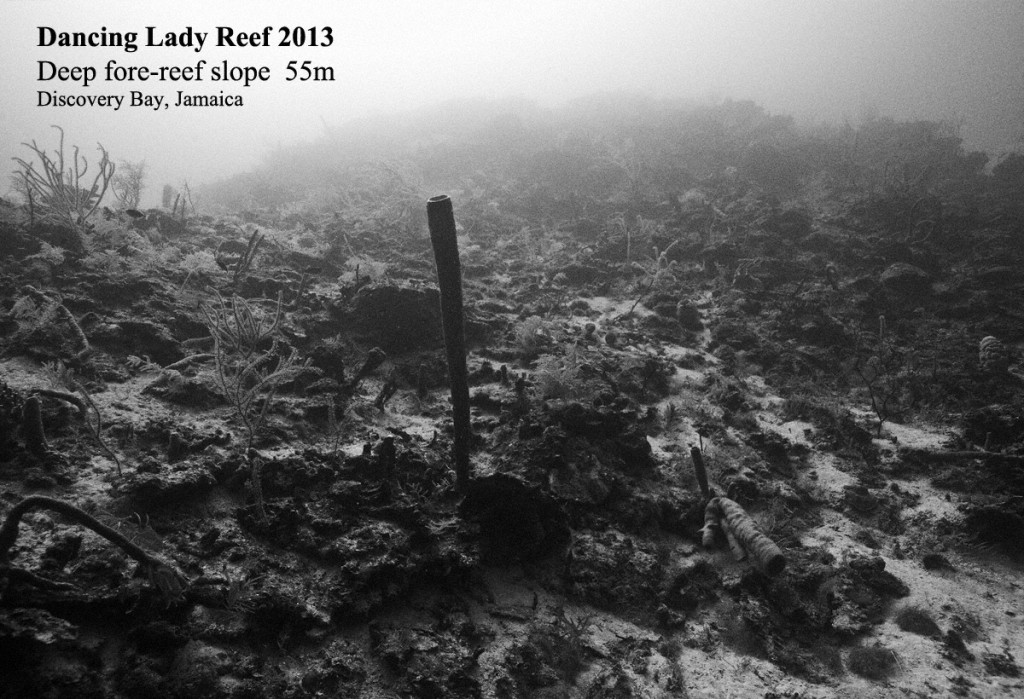Caribbean Coral Reefs Through Time: 1972-2013
As this planet spins ever faster on a collision course with humanity we need to work harder, smarter, and more ferociously than ever towards a sustainable future. In our data-driven society it is my belief that these photographic time series speak far louder than words to convey the urgency for action.
Tropical coral reefs are the most wondrous expression of life in the sea. Long before there were rain forests, or even life on land, there were reefs in the sea that evolved into the vibrant, underwater fantasy worlds we were introduced to by the Undersea World of Jacques Cousteau. Their vibrant biodiversity holds incredible potential for advancing medical science and understanding life. More practically though, reefs are a major source of food for about a billion people, protect shorelines, may be co-located with oil and gas fields, and tragically, too often become the final resting grounds hapless ships. Sadly, reefs are deteriorating faster than anyone could have imagined when I began my reef studies in 1969.
Here presented for the first time are two sets of coral reef images from the Florida Keys and the North Coast of Jamaica that reveal just how much Caribbean coral reefs have changed since the 1970’s when I began my ecological studies of these significant reef landscapes.
Scroll sideways with your mouse
Carysfort Reef, Florida Keys 1975 -2014
My studies of human impacts on reefs began in the Florida Keys with baseline surveys of Carysfort Reef, Key Largo and Long Key Reef, Dry Tortugas in 1974-75. Carysfort was the most spectacular reef throughout the Keys and Long Key provided a good reference point at the other end of the island chain. These data are now the benchmarks by which we assess coral reef change in the Florida Keys. Reefs do not produce large amounts of extractable resources, and are not able to withstand the stress of over-harvesting. The Keys are at the downstream end of the hydrology of South Florida, a system with explosive human population and agricultural growth in the last 50 years. The Gulf Stream, which flows past the Keys, may also be a source of stress as it carries materials from elsewhere in the Caribbean and Gulf of Mexico. These photographs of the Acropora palmata zone on Carysfort Reef, Key Largo, FL were taken from the same vantage point from 1975 to 2014. They document the loss of over 95% of the living coral cover. In 1975, the shallow Acropora palmata zone consisted of large colonies oriented into the prevailing seas with a high degree of three-dimensional complexity. By 1985, the colonies had suffered physical damage from boat groundings and storms. Large fragments of colonies were strewn about the substrate. The ecological impacts of the mass mortality of the spiny black sea urchin, Diadema antillarum, had also begun to be apparent with the increased growth of macroalgae on the substrate. By 2004, coral cover was below 5% and dead colonies had the appearance of melting into the substrate as bioerosion by boring sponges and invertebrates rapidly eroded the coral skeletons. By the summer of 2014, there were no living Elkhorn coral colonies in our study transect. The reef has lost much of its three dimensional structure and its framework-building capacity. The dead skeletons of the once dominant species, A. palmata, have become badly eroded rubble fragments in less than 30 years.
Carysfort Reef Decline – Timelapse Series
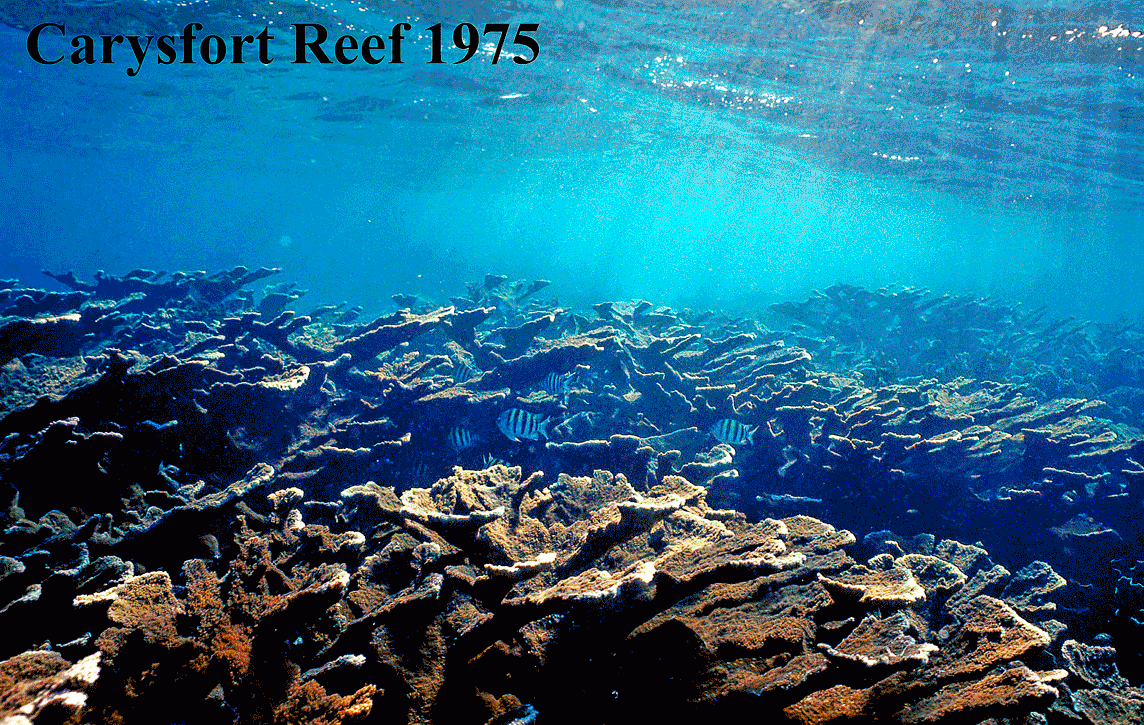
Carysfort reef time series
Discovery Bay, North Coast of Jamaica
In 1969, when I began my studies at the Discovery Bay Marine Laboratory, the reefs of the Jamaican North Coast were the most luxuriant Caribbean reefs known to science. Access to superb underwater cameras and darkroom equipment gave me the opportunity to capture these great reefs on film before their ecological collapse from hurricanes, overfishing, sea urchin mass mortality, bleaching, diseases, and coastal development making them the poster child of Caribbean reef degradation. My early photographs have taken on a historical benchmark significance I could not have imagined. For example, one 1972 landscape image of the shallow Acropora palmata zone of Dancing Lady Reef was used at the beginning of Jeremy Jackson’s TED talk “How We Wrecked the Ocean.” Jeremy’s powerful talk has been widely distributed and has over 375,000 views on TED and YouTube combined. More recently, they formed the centerpiece of “From Despair to Repair”, a video by the International Union for the Conservation of Nature that accompanies the most exhaustive report to date of historical Caribbean coral reef change.
Decline of the Dancing Lady Reef in Jamaica. Scroll sideways with your mouse
The image sets displayed here span the depth range of the reef. The shallow Acropora palmatea zone (1 to 6 m) is exposed to the full power of the incoming swell which directs the growth of coral to form a perfect natural breakwater. Large hurricanes can cause catastrophic damage but normally, reefs would regrow in relatively short order; that is until recently. In the last 40 years, the cascade of stress from local to global has reduced this resiliency to the point of ecological collapse.
Scroll sideways with your mouse
Seaward of the A. palmata Zone, colonies of staghorn coral, Acropora cervicornis, formed vast fields of delicate branches that grew amongst colonies of the massive star coral, Orbicella (Montastrea) annularis. The two species gave the reef its morphology. The branching canopy afforded fish protection from larger reef predators while the massive corals contributed to reef morphology. The A. cervicornis branching patterns followed the flow lines of surge and water flow as the delicately branching coral begins to overtop the more massive colony of Montastrea annularis (14m depth). These corals no longer exist. This part of the reef stretched to 15-20 meters where corals adapted to the deeper, low light environment begin to assume ecological dominance. The fore reef slope of Dancing Lady Reef is almost entirely constructed by colonies of the Montastrea annularis species complex. Their flattened colony morphology is an adaptation to optimize light energy capture and colony expansion rates under the pressure of decreased light availability at depth. The cover of these corals is less than 25% of 1972 estimates.
Scroll sideways with your mouse
Deeper on the fore reef slope the fragile lettuce corals in the genus Agaricia, became dominant due to their abilities to grow well at low light levels. The large colonies of Agaricia in this picture span .5 to 1 meter across. There is virtually no diving, fishing, or local disturbance to these corals. Their disappearance was unexpected as the deeper waters are supposed to have reduced levels of anthropogenic stress.
Scroll sideways with your mouse
IN SUM:
My colleagues and I had the privilege of experiencing Caribbean coral reefs while they were still vibrant but since then a community phase shift replaced the shallow reefs with macroalgae. Most people alive today have never seen a robust Caribbean coral reef but may have some inkling that the reefs have changed. To most people the fact that reefs are underwater somehow reduces their level of concern and participation in reef conservation; imagine the public outcry for action if 98% of the trees in Sequoia National Forest suddenly died? Hopefully, these compelling image time series will break through our cultural denial to initiate more effective coral conservation. My early reef landscape photographs are visual benchmarks to help people understand just how much ecological degradation has occurred in less than a human generation. Dancing Lady and Carysfort Reefs are not isolated cases of ecological collapse. On the contrary, they are representative of the majority of reefs throughout the Caribbean Florida and the Bahamas. It is my sincere hope that they strike an undeniable visceral chord within you that forces you to realize the seriousness of the ecological catastrophe we are facing in the Caribbean and tropical Western Atlantic.
Seventy-five percent of the Earth’s coral reefs are threatened, especially in coastal areas of the Indo-Pacific and Caribbean. The very adaptations that made reefs so successful for hundreds of millions of years now make them vulnerable to the direct and indirect impacts of human activities that extract living resources, foul water or alter the climate beyond tolerable ranges. This makes reef systems more sensitive to a changing environment than are our finest oceanographic instruments and making them the harbingers of declining ocean health and global environmental security. Scientists and resource managers are scrambling to find ways to assess coral reef health, to identify the causes driving reef deterioration, and to stop their slide to extinction. Corals expose their tissues to the environment such that virtually all change is manifested by changes in their fragile living surface as a new a suite of selection pressures arose. Coral bleaching was something we induced in the lab by prolonged darkness or exposure to high light intensities. Black band disease, the first of many coral diseases to be discovered, had just been reported from Bermuda but was totally unknown in Jamaica. In the years that followed coral colonies lost tissue bit by bit or through catastrophic events such as destructive storms, the near cessation of herbivory through continued overfishing and urchin mass mortality, diseases, bleaching, increased coastal nutrification, global warming, ocean acidification, and atmospheric dust.
As the coral reef crisis deepens, I believe we need redouble our efforts to develop more committed public policy, engage stakeholders, and utilize economic models that actually save reefs. As reefs have begun their not-so-slow slide toward extinction, the phrase about coral reefs being the oldest, most productive and diverse ecosystems on Earth has been overused to the point of desensitization, like violence on television. On one hand we laud the importance of reefs, but despite the rhetoric the political will to develop meaningful conservation remains sorely lacking. The Florida Keys have lost over 95% of their living coral since 1975, Caribbean reefs are in shreds, and coral cover on the Great Barrier Reef has halved in the last 27 years.
– Phil Dustan, Global Ecologist, Coral Reef Research Programs
If you wish to read Phil’s Caribbean Reef Report, click here.
We wish to thank the Waitt Foundation (www.waitt.org) who provided support in 2013 to return to these sites and photograph the change once again and Liv Wheeler (TreestoSeas.org) for her expert diving assistance on Dancing Lady Reef.

